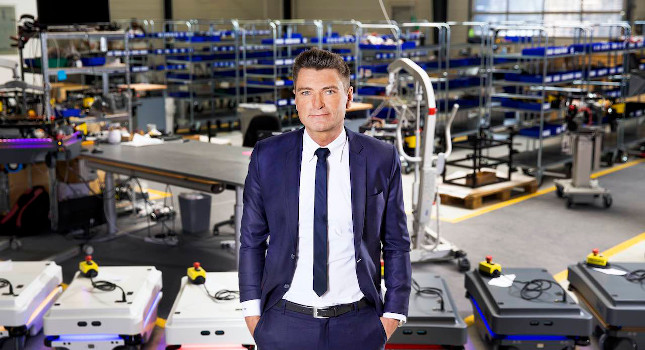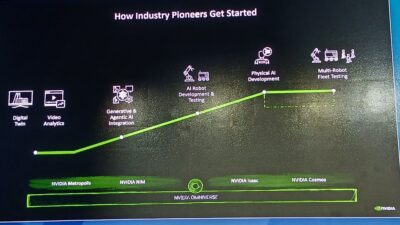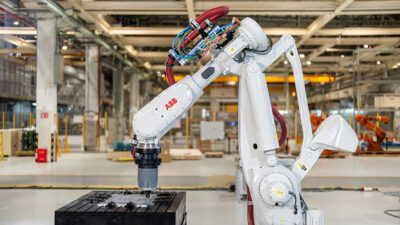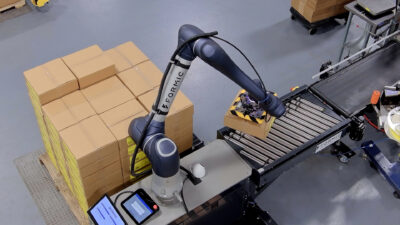The market for autonomous mobile robots (AMRs) is growing fast, and there is a lot of demand globally for them in traditional automation, in non-automotive sectors.

Autonomous mobile robots (AMRs) were a hot topic at the 3rd Forum Cobotyki in Wrocław, Poland which had more than 300 participants, including Thomas Visti Jensen, CEO of Mobile Industrial Robots ApS. the forum. The growing AMR presence in manufacturing is matched by a growing demand. The overall market for AMR’s in all sectors (aerial, ground and marine commercial and private) is booming, with the overall market expected to grow at 24% per year from $19B in 2018 to $54B by 2023, according to MarketsandMarkets Research. Jensen discussed his experience as the CEO of MiR and what the future of mobile robotics looks like with Control Engineering Poland.
Michael Majchrzak, Control Engineering Poland: MiR was one of the first companies to launch AMR’s for industry and logistics. Did you do any market research before deciding to take the leap?
Thomas Visti Jensen: Yes. When Niels (Niels Jul Jacobsen, founder of MiR), reached out to me to be the CEO, he asked me if I was ready for another journey. I started looking into the product and calling some of my contacts in Germany and in the USA and so on, and I spoke with them about the product and nobody really understood the concept. They would ask, “Where’s the market?” or “We don’t see any potential there,” or whatever. I had the same feeling, but I could see some potential in the flexibility that was inherent in the product and the fact that it was very easy to program, it was safe, and I knew that there were companies that were looking for a solution to automate logistics operations.
MM: What about finding engineering talent, is that difficult in today’s quickly automating environment?
TVJ: Everybody’s asking, “Is it difficult to find employees?” It’s not that difficult, thankfully, because there’s so much focus on engineering development in Denmark, and we now see a lot of foreigners willing to move to Odense (Denmark, the headquarters of MiR) because there’s a lot of exciting jobs there. I’m not saying it’s been easy, but it’s been relatively easy for us to find the good employees compared to the whole market situation as it is right now.
MM: AMRs are expanding very rapidly across many sectors, private and commercial. What sectors you are focusing on, and where do see the biggest potential for your products?
TVJ: The main driver in the beginning was automotive producers and suppliers, as they were willing to invest in the technology. They were also the first sector to move into automation. After automotive came electronics, and then we saw fast moving consumer goods (FMCG) and now logistics. So this has been the development of the market. And of course, hospitals. Hospitals have a big potential in the long distances that are required moving medical equipment around buildings. Our medical equipment robots are programmed to take the elevators themselves and are moving from room to room. So that’s a technology that we have been developing together with the market and trying to understand that market better during the journey. Automotive is 35% of our revenue today.
Since the company has only a relatively short history, it really depends on where we started, and we started in the automotive sector, and we have a longer history there, more projects and more implementations. Now we can see that logistics is moving very fast, so we have been focusing on logistics over the last two years.
We are also focusing more into verticals now, but more important for our strategy is that we try to keep our products very simple. So one of the successes of Universal Robots (UR) and MiR is that we have very few products in our portfolio, and we are very good at those products, as opposed to being mediocre at a lot of products. When we have perfected a good product and the platform to go with it, we immediately expand it globally. MiR has been thinking globally from the very beginning. This is a simple, but effective, strategy.
MM: Which regional markets are the most important for you, and how strategic are the markets in this region of Central and Eastern Europe?
TVJ: If you look at robotics overall, China is a very large market for all manufacturers. Over one-third of all robots produced go to China. In our case right now, about 10-12% of our sales go to China. The USA is our second largest market with more than 25% of sales there. Europe is our largest market with over 50% of total revenue. Eastern Europe is around 14% of total revenue. Poland is the most important country for us in this region, basically because there are many large multinational players here. All of the big players and their suppliers are here in Poland. Even today, Whirlpool has a presentation in the form of a case study from their Polish operations. Overall, we expect the market for logistical AMR’s to grow from around 100,000 overall installed base today to more than 700,000 until by 2022.
Michael Majchrzak is with Control Engineering Poland. Edited by Chris Vavra, associate editor, Control Engineering, CFE Media and Technology, [email protected].
MORE ANSWERS
Keywords: mobile robots, autonomous mobile robots, AMRs
Mobile robots are a growing market all over the world.
There is a lot of demand for mobile robots beyond the automotive and automation sectors.
China, North America and Europe are among strong AMR markets.
CONSIDER THIS
What technology advances will help expand mobile robots’ footprint in manufacturing?



